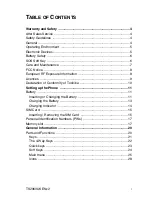
- 23 -
The waveform at the dual Tx VCO output is the GMSK-modulated signal centered at the desired GSM
channel frequency. A phase-locked loop circuit is used to translate the GMSK-modulated signal from IF
to RF primarily for two reasons:
1. Phase-locked loops provide a lowpass filter function from the reference input to the VCO output. This
results in a bandpass function centered at the desired channel frequency that provides steep, well-
controlled rejection of the out-of-band spectrum.
2. The resulting output bandpass function is virtually unchanged as the transmitter is tuned over
channels spanning the GSM operating band.
The PA is a key component in any transmitter chain and must complement the rest of the transmitter
precisely. For GSM band operation, the closed-loop transmit power control functions add even more
requirements relative to the UMTS PA. In addition to gain control and switching requirements, the usual
RF parameters such as gain, output power level, several output spectrum requirements, and power
supply current are critical. The gain must be sufficient and variable to deliver the desired transmitter
output power given the VCO output level, the subsequent passive devices’ losses, and the control set
point. The maximum and minimum transmitter output power levels depend upon the operating band
class and mobile station class per the applicable standard. Transmitter timing requirements and inband
and out-of-band emissions, all dominated by the PA, are also specified by the applicable standard.
The active dual Tx VCO output is applied to the dual power amplifier to continue the transmit path, and
feedback to the RTR6250 IC to complete the frequency control loop. The PA operating band (EGSM or
DCS/PCS) is selected by the MSM device GPIO control (GSM_PA_BAND).
3.3 WCDMA Mode
3.3.1 Receiver
The UMTS duplexer receiver output is routed to LNA circuits within the RFR6250 IC. The LNA gain is
dynamically controlled by the MSM6250A IC to cover full receiver dynamic range and to save current
consumption.
The UMTS LNA output is routed to the down conversion mixer inputs, in the RFR6250 IC, through a
band selection filter that transforms a single-ended 50-Ω source to differential 100-Ω load impedance
that is matched to the RFR6250 IC. The RFR input uses a differential configuration to improve second-
order inter-modulation and common mode rejection performance. The RFR6250 IC input stages include
MSMcontrolled gain adjustments that further extend receiver dynamic range.
Z3X-BOX.COM
Summary of Contents for L601i
Page 1: ...Date October 2006 Issue 1 0 Service Manual Model L601i Service Manual L601i Z 3 X B O X C O M ...
Page 3: ... 4 Z 3 X B O X C O M ...
Page 45: ...3 TECHNICAL BRIEF 46 Figure PM6650 2 Functional Block Diagram Z 3 X B O X C O M ...
Page 105: ...4 TROUBLE SHOOTING 106 Audio AMP 22 and 23 pin of CN501 Z 3 X B O X C O M ...
Page 109: ...4 TROUBLE SHOOTING 110 Ear_sense_n pin R506 R507 R505 Z 3 X B O X C O M ...
Page 112: ...4 TROUBLE SHOOTING 113 Q400 Q401 VBAT T GND Z 3 X B O X C O M ...
Page 125: ...5 DOWNLOAD 126 Click on X button to use another function Z 3 X B O X C O M ...
Page 130: ...6 BLOCK DIAGRAM 131 6 2 Interface Diagram L601i Interface Diagram Z 3 X B O X C O M ...
Page 132: ...6 BLOCK DIAGRAM 133 Top Side Z 3 X B O X C O M ...
Page 133: ... Bottom Side 6 BLOCK DIAGRAM 134 Z 3 X B O X C O M ...
Page 141: ... 142 8 PCB LAYOUT Z 3 X B O X C O M ...
Page 142: ... 143 8 PCB LAYOUT Z 3 X B O X C O M ...
Page 143: ... 144 8 PCB LAYOUT Z 3 X B O X C O M ...
Page 144: ... 145 8 PCB LAYOUT Z 3 X B O X C O M ...
Page 145: ... 146 Z 3 X B O X C O M ...
Page 151: ... 152 Z 3 X B O X C O M ...
Page 153: ... 154 Z 3 X B O X C O M ...
Page 176: ...Note Z 3 X B O X C O M ...
Page 177: ...Note Z 3 X B O X C O M ...
















































